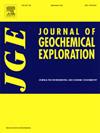Geochemistry of the Oligocene-hosted manganese ores and the host sediments in the Thrace Basin, Türkiye: Implications for genesis and exploration of the Paratethyan Mn deposits
IF 3.4
2区 地球科学
Q1 GEOCHEMISTRY & GEOPHYSICS
引用次数: 0
Abstract
The Early Oligocene Binkılıç Mn deposit occurs within the laminated clays and clayey carbonates of the Thrace Basin, NW Türkiye. Carbonatic and oxidic ores generally alternate with greenish to brownish grey laminated clays. The Mn-bearing laminated clays are unconformably overlain by deltaic Miocene sediments consisting of clay, sand and lignite.
Trace element and REE contents of the Mn oxides and the laminated host Oligocene clays of the Binkılıç Mn deposits are quite similar. Mn-bearing Oligocene clays and Mn oxides typically show enrichment in Ni, U, Tl, Mo, Co, W, As, Hg, Cu and V relative to PAAS. While Sr and Ba extremely enriched in Mn oxide ore relative to PASS, such enrichment is not observed in the Oligocene clay. A similar trace element enrichment of the Mn oxides and the host Oligocene clays indicates that both were formed under similar geochemical conditions. The fact that the oxidic manganese ore is rich in these trace elements, but the carbonate ore is poor, may indicate that a local reducing environment developed as a result of organic matter decomposition, and that Mn carbonates were formed secondarily in the post-burial stage.
Trace elements are highly enriched in Mn oxides and clays, are clearly organophylic elements and indicate that the bioproductivity of Paratethyan sea was high in the early Oligocene and that the Mn deposit was formed by anoxic processes as a result of the development, precipitation and decomposition of organic substances. Organic matter-rich sediments at the bottom of deep basins must have ensured the continuity of reducing conditions while transferring the high amount of organophylic trace elements to the seawater. Mn and other anoxia proxy elements were concentrated in the anoxic water column and then carried to shallow marine environments by upwelling deep currents, where they may have been precipitated as Mn oxides in the early Oligocene. In addition to Mn, we propose that a trace element association consisting of Ni, U, Tl, Mo, Co, W, As, Hg, Cu, V anomaly of the Oligocene clays can be used as a prospecting tool for Oligocene-hosted manganese deposits around the Paratethyan Basin.
色雷斯盆地渐新世锰矿石及其寄主沉积物地球化学特征[j] .中国地质大学学报(自然科学版)
早渐新世Binkılıç锰矿床赋存于北西色雷斯盆地的层状粘土和粘质碳酸盐中。碳酸盐和氧化矿石通常与绿色到棕灰色的层状粘土交替。含锰层状粘土被由粘土、砂和褐煤组成的中新世三角洲沉积物不整合覆盖。Binkılıç锰矿床的锰氧化物和层状寄主渐新世粘土的微量元素和稀土元素含量非常相似。渐新世含锰粘土和Mn氧化物相对于PAAS富集Ni、U、Tl、Mo、Co、W、As、Hg、Cu和V。Sr和Ba在氧化锰矿石中相对于PASS富集,而渐新世粘土中则不富集。锰氧化物和寄主渐新世粘土中微量元素的富集特征相似,表明两者形成于相似的地球化学条件下。氧化锰矿石富含这些微量元素,而碳酸盐岩矿石缺乏这些微量元素,这可能表明有机质分解形成了局部还原环境,埋后阶段次生形成了碳酸锰矿石。微量元素在锰氧化物和粘土中高度富集,是明显的有机植物元素,表明早渐新世旁特提洋海生物生产力较高,表明锰矿床是由有机物发育、沉淀和分解的缺氧过程形成的。深盆底部富含有机质的沉积物在向海水输送大量有机微量元素的同时,也保证了还原条件的连续性。Mn等缺氧替代元素富集于缺氧水柱中,并被上升流带至浅海环境,可能在早渐新世以锰氧化物的形式沉淀在浅海环境中。除Mn外,渐新世粘土中由Ni、U、Tl、Mo、Co、W、As、Hg、Cu、V组成的微量元素组合异常可作为旁特提岩盆地渐新世含锰矿床的找矿工具。
本文章由计算机程序翻译,如有差异,请以英文原文为准。
求助全文
约1分钟内获得全文
求助全文
来源期刊

Journal of Geochemical Exploration
地学-地球化学与地球物理
CiteScore
7.40
自引率
7.70%
发文量
148
审稿时长
8.1 months
期刊介绍:
Journal of Geochemical Exploration is mostly dedicated to publication of original studies in exploration and environmental geochemistry and related topics.
Contributions considered of prevalent interest for the journal include researches based on the application of innovative methods to:
define the genesis and the evolution of mineral deposits including transfer of elements in large-scale mineralized areas.
analyze complex systems at the boundaries between bio-geochemistry, metal transport and mineral accumulation.
evaluate effects of historical mining activities on the surface environment.
trace pollutant sources and define their fate and transport models in the near-surface and surface environments involving solid, fluid and aerial matrices.
assess and quantify natural and technogenic radioactivity in the environment.
determine geochemical anomalies and set baseline reference values using compositional data analysis, multivariate statistics and geo-spatial analysis.
assess the impacts of anthropogenic contamination on ecosystems and human health at local and regional scale to prioritize and classify risks through deterministic and stochastic approaches.
Papers dedicated to the presentation of newly developed methods in analytical geochemistry to be applied in the field or in laboratory are also within the topics of interest for the journal.
 求助内容:
求助内容: 应助结果提醒方式:
应助结果提醒方式:


